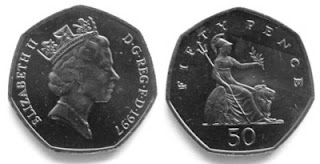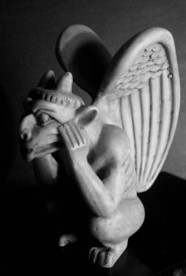I'm not saying for a minute that the Euro is such a 'hard currency', but it's surely a step in that direction. It never ceases to amuse me how the very people who argue hardest for neoliberal economics and laissez-faire policies will adopt a wholly contrary stance on this point. It rather undermines their credibility, I tend to think.
 Anyway, be that is as it may, I've always thought the Two Pound coin was Britain's best argument against joining the Euro; it's a lovely design, and one that would surely be ditched were Britain to find the nerve to join everyone else on the dancefloor. Because let's face it, if Britain does ever join in, she'll surely follow the Benelux countries in having the head of state on the 'national' side of every coin, which'd be a fierce shame. I'd rather see a mixture of designs -- maybe a selection of Shakespeare, Newton, Stonehenge, Britannia, and the monarch, whether it be Elizabeth II, Charles III or George VII.
Anyway, be that is as it may, I've always thought the Two Pound coin was Britain's best argument against joining the Euro; it's a lovely design, and one that would surely be ditched were Britain to find the nerve to join everyone else on the dancefloor. Because let's face it, if Britain does ever join in, she'll surely follow the Benelux countries in having the head of state on the 'national' side of every coin, which'd be a fierce shame. I'd rather see a mixture of designs -- maybe a selection of Shakespeare, Newton, Stonehenge, Britannia, and the monarch, whether it be Elizabeth II, Charles III or George VII.Britannia, of course, who currently sits imperiously on the fifty pence, clearly having long grown accustomed to having been violated by the Romans, will not be featuring on new British coins for the foreseeable future, though; all the current coins, barring the marvellous Two Pound piece, have been redesigned to delightful effect.
 Have you seen the new designs yet? They're gorgeous. The brainchild of Matthew Dent from Bangor in North Wales, the pound coin features the royal coat of arms, with the three lions of England being shown at the top left and bottom right, the Scottish lion rampant in the top right, and the Irish harp in the bottom left.
Have you seen the new designs yet? They're gorgeous. The brainchild of Matthew Dent from Bangor in North Wales, the pound coin features the royal coat of arms, with the three lions of England being shown at the top left and bottom right, the Scottish lion rampant in the top right, and the Irish harp in the bottom left.
The six lower-value coins show details from the Arms of Dominion, to give the coat of arms its proper name. They're designed to be assembled in a formation, which should keep kids and drunks entertained for hours.
The people at the mint are naturally very excited about the new designs, and today's Independent quotes Andrew Stafford, the chief executive, as saying that 'It is the only work of art that every member of the general public touches every day, that is important to the nation's way of life.'
That's an interesting point, especially given that there appears to be no plans for a specific Scottish variant on these patterns. You might wonder why there would be, but there'd be a good reason for one. This version of the Arms of Dominion has been used since 1837 but is never used in Scotland, which features the Scottish lion rampant in the first and fourth quarters, with the English lions restricted to the second quarter. This makes sense, after all, since England and Scotland were meant to be equal partners in the 1707 Act of Union.
The Scots, therefore, will be handling coins emblazoned with the English version of the coat of arms, but the English won't ever be handling the Scottish version. Expect someone to get uppity about this soon.
Incidentally, it seems ironic that it should have been a Welshman who came up with this idea, considering that -- being a principality rather than a kingdom -- Wales isn't explicitly recognised on the coat of arms. For the purposes of the Arms of Dominion, Wales is part of England.
This may well annoy people too.
 Have you seen the new designs yet? They're gorgeous. The brainchild of Matthew Dent from Bangor in North Wales, the pound coin features the royal coat of arms, with the three lions of England being shown at the top left and bottom right, the Scottish lion rampant in the top right, and the Irish harp in the bottom left.
Have you seen the new designs yet? They're gorgeous. The brainchild of Matthew Dent from Bangor in North Wales, the pound coin features the royal coat of arms, with the three lions of England being shown at the top left and bottom right, the Scottish lion rampant in the top right, and the Irish harp in the bottom left.The six lower-value coins show details from the Arms of Dominion, to give the coat of arms its proper name. They're designed to be assembled in a formation, which should keep kids and drunks entertained for hours.
The people at the mint are naturally very excited about the new designs, and today's Independent quotes Andrew Stafford, the chief executive, as saying that 'It is the only work of art that every member of the general public touches every day, that is important to the nation's way of life.'
That's an interesting point, especially given that there appears to be no plans for a specific Scottish variant on these patterns. You might wonder why there would be, but there'd be a good reason for one. This version of the Arms of Dominion has been used since 1837 but is never used in Scotland, which features the Scottish lion rampant in the first and fourth quarters, with the English lions restricted to the second quarter. This makes sense, after all, since England and Scotland were meant to be equal partners in the 1707 Act of Union.
The Scots, therefore, will be handling coins emblazoned with the English version of the coat of arms, but the English won't ever be handling the Scottish version. Expect someone to get uppity about this soon.
Incidentally, it seems ironic that it should have been a Welshman who came up with this idea, considering that -- being a principality rather than a kingdom -- Wales isn't explicitly recognised on the coat of arms. For the purposes of the Arms of Dominion, Wales is part of England.
This may well annoy people too.

No comments:
Post a Comment